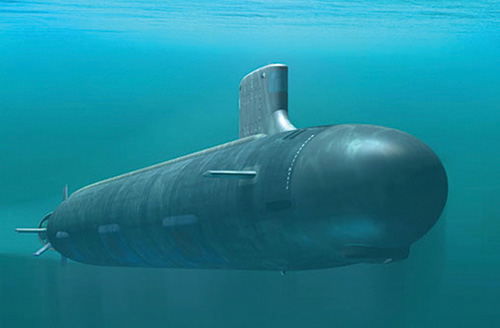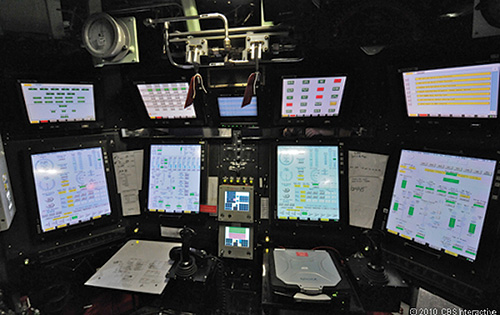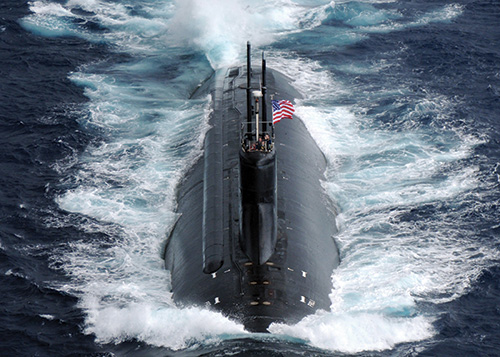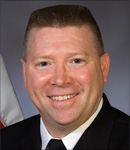As a former U.S. Navy captain with over 20 years’ experience in operating nuclear-powered submarines, Mike Varney draws insightful parallels between commanding a submarine and operating a utility. He offers relevant lessons learned from his time with the Navy, as well as a glimpse into the cutting-edge naval technologies that the utility industry is now adopting.
A submarine might not be the first comparison that comes to mind when thinking of utilities. Yet they have more in common than one would imagine. In some ways, a submarine is a miniature utility in totality – complete with a nuclear-powered generator, a distribution system, storage capacity, operations personnel and even a smart-grid-like operations network. And that’s just electricity—submarines also have sewage, water and air networks that are all required to stay afloat. Being submerged thousands of feet underwater can be fairly daunting if the lights go out. In this environment, power is not just a luxury; it’s a matter of life and death.

In my career as a submarine commander with the U.S. Navy, I dealt with many of the same challenges that utilities transitioning to smart grids are now facing. Challenges like how to establish situational awareness to operate more efficiently; how to build a knowledge repository into your operational processes to safeguard against staff turnover; and how to increase resiliency so you can bounce back when you, quite literally, take a hit. While these issues are new to utilities in the nascent phase of their smart grid networks, the Navy encountered these challenges years ago—making the technology of today’s submarine a glimpse into the technology of tomorrow’s utility.
Situational awareness provides visibility into daily operations
Operating in dark ocean depths, submarines are able to ‘see’ using sonar that gathers and interprets massive amounts of acoustic data from everything under the sea, including marine life and other ships in a 1,000-mile radius. It’s a finely tuned technology that provides unparalleled situational awareness, but one that creates an overwhelming number of data events. All of this data can be information overload and, quite frankly, useless unless you’re able to cut through the ‘noise’ instantaneously. In the case of a naval ship, this ability allows you to pinpoint the enemy warship over the horizon in a big, noisy ocean. Or, for a utility, you can stay on top of network exceptions, security threats and operational problems.

As a result, modern submarines operate an intelligent software solution that integrates massive amounts of data from sonar including water, environment and weather conditions, ship and navigational data, off-ship intelligence data, weapons systems data and, of course, visual and video data from the periscope when at shallow depths. The system can quickly determine which data to ignore and what warrants alerting operations personnel to act upon immediately.
A utility’s smart grid faces the same challenge – all the data it gathers is invaluable for creating situational awareness and visibility into its daily operations, allowing the utility to more swiftly pinpoint outages, security breaches and other threats. But it’s important to access that invaluable awareness without increasing manpower. To achieve this, utilities require a grid management application that integrates with OT and IT systems to provide a contextual, real-time view of operations. By synthesizing data relayed by field devices and integrating it with data from other networks and systems, the application can analyze all the information together, apply business rules to manage the vast majority of data events, and only alert operators to important anomalies and security threats.
Creating a knowledge repository through machine learning
As the commanding officer in charge, it was a given that I could operate the submarine’s systems better than anyone else on the ship. Although it took me 30 years to reach that level of proficiency, new recruits today could start out operating at about 90 percent of my capacity on their first day – all based on the information and tools now available to them. This is because, over the last several years, the Navy has developed technologies that compensate for operators’ lack of experience by building the expertise right into the operating system. The average age of a worker on a submarine is 24, and he or she only spends about two years in any position before either moving up the chain of command or transferring to another ship or to a shore facility. So we recognized the risk inherent in departing knowledge and experience a long time ago. When the Navy transitioned to digital and computer OT systems, we had to build systems and technologies that would continue to improve our performance and our peoples’ performance without relying solely on workers staying in a job for over 30 years. The systems themselves compensated for, and mitigated, the ‘brain drain’ that many utilities are now facing.
This is a key lesson for the utility industry. As the majority of its most experienced operators are on the brink of retirement; utilities are facing an imminent loss to their operational knowledge base. They, too, need to build that knowledge base into their operating systems to avoid losing it through staff turnover. The way to do this is with a highly configurable grid-management application that is capable of machine learning. The more business rules you ‘teach’ your technology platform – complex procedural rules that apply specifically to your unique operational needs – the more sophisticated and effective the virtual operator becomes. This allows you to operate your utility just as effectively, whether your operations personnel have two years of experience or 20. In addition, a virtual operator increases efficiency by allowing you to manage operations with the minimum head count possible.
Improving resiliency to weather the storms
For submarines in a warfare situation, resiliency is paramount to survival—the consequences of losing power can be a matter of life or death. If you’re hit by a depth charge, you need to get any affected systems back online in a hurry in order to return fire. The best way to do that is to be able to learn from past experiences in order to anticipate the most efficient way to restore power based on the type and location of damage you’ve sustained.
While utilities may not need to worry about being hit by torpedoes, severe weather conditions like wind, ice, fires, tornadoes and hurricanes are a very real threat. And although there’s nothing you can do to prevent bad weather, you can use past experience to be better prepared for it. Specifically, utilities can use the data collected from their smart grids to analyze historical patterns of which systems tend to go down when, and then correlate that information with past and current weather patterns. When linked to real-time grid and weather conditions, systems are able to predict events, incidents and problems, resulting in more proactive and predictive operations. The technology, when coupled with new processes, matures the operations teams and enables utilities to better anticipate, prepare for, handle and recover from outages due to severe weather situations. This, in turn, creates more stable and resilient networks.
A smart grid software solution with this capacity for pattern analysis and correlation represents the ultimate level of machine learning, and allows a utility to practice “predictive operations” and mature its operations. Through a solution like this, utilities will be able to monitor and analyze patterns on the grid and bring to light issues that otherwise may not be found. This is key, because being both predictive and proactive is crucial to good customer service—and with customers more dependent than ever on their electricity supply, they have equally increased expectations for the stability and consistent reliability of the network.
Cutting-edge technologies enable smooth sailing
As national energy strategies drive the public to lower their consumption, utilities’ revenue streams are feeling the crunch, and they need to operate more efficiently than ever to stay profitable. Smart grids offer this capability as long as you can harness and extract value from the massive volumes of data they provide. While the Navy may have been a pioneer in this realm, utilities are certainly catching up—in part thanks to cutting-edge technologies and industry-specific software solutions that integrate seamlessly with all systems. Solutions that can be programmed with business rules to automate operations, and have the analytical capability to make operations predictive rather than reactive, are mission critical to a utility’s success.

About the Author
 Mike Varney spent over 20 years in the U.S. Navy, where his experience included commanding the most advanced nuclear-powered submarines in complex operations around the globe, leading a special operations team in reconstruction efforts in Afghanistan, and directing a Naval Operations Center. He has also served as a strategic advisor for the U.S. Department of Defense, a senior evaluation officer at nuclear power plants, and an advisor to companies providing smart grid technologies to utilities.
Mike Varney spent over 20 years in the U.S. Navy, where his experience included commanding the most advanced nuclear-powered submarines in complex operations around the globe, leading a special operations team in reconstruction efforts in Afghanistan, and directing a Naval Operations Center. He has also served as a strategic advisor for the U.S. Department of Defense, a senior evaluation officer at nuclear power plants, and an advisor to companies providing smart grid technologies to utilities.
Mike holds Bachelor of Science degrees in Nuclear and Marine Engineering as well as Engineering Management. He also holds a Master’s of Science degree in National Security Strategy. Today, he is the senior director of strategic advisory services at Bit Stew Systems, where his knowledge of operational standards, emerging methodologies and key market drivers ensures that Grid Director™, Bit Stew’s world-leading smart grid operations platform, provides business value to utilities in the real-time network operations domain.







